Until the end of this month (September) the government is giving companies an extra £3,000 per apprentice they take on. That’s in addition to the CITB grants that now cover travel and accommodation as well as training fees... find out more at bit.ly/stonetrail
Minister for Apprenticeships Gillian Keegan finally signed off the funding for a stonemasonry Trailblazer apprenticeship just too late to be included in the July/August issue of Natural Stone Specialist, although you will have found out about it if you follow the magazine on LinkedIn or have signed up to its Stone Bulletin.
The signing off of the funding for training providers was the final step in giving stone its own Trailblazer apprenticeship.
There is only one stonemasonry apprenticeship but with various routes through it focussing on specialities such as interior or exterior fixing, heritage stonework and memorial masonry.
A requirement for Trailblazers is that they include off-the-job as well as on-the-job training and a final assessment.
Three colleges have so far signed up to deliver the stone Trailblazer – Bath, the Building Crafts College in London and York. They all say they have apprentices ready to start this month (September). Only Bath is offering all the routes available for the apprenticeship, including memorial masonry, which it is running in conjunction with Morley Young Training Services.
The stonemasonry Trailblazer was achieved after a five-year process involving the stone industry and the Institute of Apprenticeships & Technical Education, formed by the government to work with industry on the development of the apprenticeships and other vocational training. You can see the knowledge, skills and behaviours (KSBs) required for the various routes to the stone Trailblazer at www.instituteforapprenticeships.org/apprenticeship-standards/stonemason.
Leading the industry side was Michelle Turner, a Director of Stone Restoration Services in Ongar, Essex, who chairs the Natural Stone Industry Training Group (NSITG). She worked alongside Claire Wallbridge, Administrator of the NSITG and Training Officer of Stone Federation’s StoneTrain training arm, and others from the stone industry to deliver the Trailblazer.
One of the reasons the funding took a while to sign off was because the Institute had offered the same level of funding for stonemasonry as for bricklaying – £11,000 a year. The colleges appealed, arguing that teaching stonemasonry requires more resources and therefore should receive more funding.
John Jefferies at Bath College says: “They did consider our appeal and they haven’t said ‘never’, but they wanted us to give it a go, get the first people through, and they will look at the level of funding again. There came a point where we just had to get on with it.”
The stone apprenticeship is one of 73 being offered by Bath across a wide range of subjects. They are being overseen by John, who has been appointed as Apprenticeship Manager. He says the Trailblazers are not like apprenticeships of old, which many companies saw as delegating training to colleges. “Now the employer has to take as much responsibility for the training as the college does,” says John. “We want apprentices to complete the course and be able to cut the mustard.”
Students have to produce a portfolio showing the range of work they have experienced, authenticated by the person who oversees them at the company they work for.
The portfolio can be produced digitally with videos, photographs and recordings.
After 24 months ‘in learning’ students should be ‘gateway ready’ for their end point assessment – and Bath College has set up an end point assessment centre specifically for the purpose.
For the assessment, stonemasonry apprentices will demonstrate their practical skills by being given a project that they will be expected to compete successfully in five hours (with a break) in front of an end point assessor, who is independent of the college. They will also have to demonstrate their understanding of what they have learnt in a ‘professional discussion’ with the assessor underpinned by their portfolio.
John says there is theory involved in stonemasonry as well as practical skills. Students have to understand geology and different architectural styles, the materials and tools, and then put it all into practice and be able to explain why work is carried out the way it is.
Anyone who did not pass English and maths GCSE at school will also have to work towards getting them, or an approved interim qualification as a ‘stepping stone’ towards them, as a condition of being funded.
The colleges are being as flexible as possible with the delivery of the apprenticeship training. At Bath, there are staggered start dates of September, January and April, so firms do not have to wait for the start of a new academic year before apprentices can be recruited.
And because there are currently only three colleges offering apprenticeship training in stonemasonry, so students might well have to travel to attend the courses, the training is being offered in block release units a week at a time. That has been made easier for firms in scope with CITB through additional new grants to cover travel and accommodation.
The first intake of stonemasonry apprentices at Bath are with employers as spread out as Jersey, Manchester, Cornwall, Birmingham, Oxford and Wells Cathedral.
Successful completion of an apprenticeship earns a pass, merit or distinction. Students can also fail, but if they fail on one or some aspects but pass others, they only have to re-take those elements they failed.

